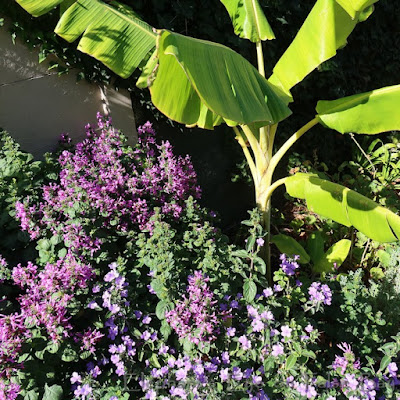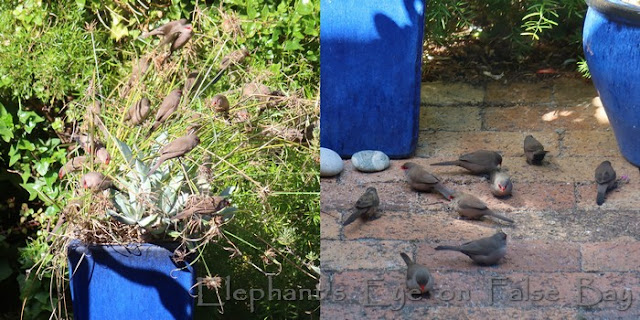False Bay garden in April and City Nature Challenge
by Diana Studer
- gardening for biodiversity
in Cape Town, South Africa
Apologies to those who are struggling to leave comments. Me too, on my own blog! Please use the Name / URL option. (Remember your comment won't appear until I have read it before publishing)
April garden vignette is this view from our kitchen door. For Through the Garden Gate. With Sarah in Dorset. Lively golden green of happy banana leaves as a counterfoil to lush autumn purples. Tall Hypoestes aristata (ribbon bush) behind and lower Barleria obtusa (Autumn violets).
 |
| Banana with autumn blues |
I inherited both purple and pure white Hypoestes aristata. I prune, chip and mulch which gives me lots of volunteer seedlings. And gentle variation in the colour on the stripy petals. The much whiter one is a seedling. Hypoestes is a sharp purply pink, but Barleria is a delightful mellow mauve.
 |
| Hypoestes aristata with Barleria obtusa |
Volunteer sedge left to go to seed and spread, feeds a large flock of tiny waxbills. Some perched delicately on the bending stalks, others on the ground hoovering up.
 |
| Waxbills on sedge |
Lavender has volunteered under the succulent pots. Plumbago auriculata coming in the gate!
 |
| Lavender and Plumbago auriculata |
On the Euryops daisy a glossy fly busy feeding and pollinating.
 |
| Euryops with pollinating fly |
Putting in my token observations for 'one more observer in the Challenge'. Oxalis caprina is a wild volunteer, a delicate one in a barely there pink.
 |
| Oxalis caprina |
The Leaning Tree of Fish Hoek is a landmark. To my surprise not yet on iNat so mine is there now. Cook Island pine Araucaria columnaris. The islands lie halfway across the world between Australia and New Zealand, in the Pacific Ocean, the country now called New Caledonia. These trees lean. 8 degrees towards the Equator (so North for us)
 |
| Cook Island pine leaning to the Equator |
This week I will be identifying photos on iNat for the City Nature Challenge (as I write La Paz in Bolivia has 4000 species, against our 3000!) Our Cape Town species range from the humungous to the miniscule. From 1 kilometre down in the depths of the ocean to 1 climbing up to Table Mountain. From the kraken of legend washed up on Kommetjie beach. To the still unnamed Table Mountain red strawberry spider I found while trawling thru MANY thousands of Unknowns.
I use my April - this month in my garden post - for an annual look back. But rolling over my garden history for May.
I invite you to join us at Elephant's Eye on False Bay. Please subscribe as you prefer
via Feedly,
or my Facebook blog page
Pictures by Diana and Jürg Studer
of Elephant's Eye on False Bay
Teal blue text is my links.
To read comments if you are in a Reader,
first click thru to the blog)
Thanks for comments that add value. Your comment will not appear until I've read it. No Google account? Use Anonymous, then please include a link to your own blog. I welcome comments on posts from the last 2 months.
Your Hypoestes aristata is beautiful and unusual. Lovely to also see the flock of waxbills in your garden. The Leaning Tree of Fish Hoek is amazing it looks as if it fall down! Thanks for joining in again this month, sorry I had been busy today and hadn't picked up your first link until just now! Sarah x
ReplyDeleteYour Hypoestes aristata froze me in place with envy. I had a vigorous specimen in my former tiny garden but still haven't succeeded in getting it to grow well in my current garden, where the best I can say thus far is that it hasn't died. The iNat City Nature Challenge is interesting - I wish I heard of it earlier.
ReplyDeleteThe friend I hike with, lives a few blocks away, has lost all her Hypoestes. Unpredictable plants?
DeleteThe Banana, Hypoestes and Barleria certainly make a lovely trio. Here the local hedge of Plumbago down the road, decades old is also flowering. So far away, and yet it blooms in sync with yours.
ReplyDeleteBest wishes for a lovely autumn and all the winter rain you need.
I'm posting as Anonymous because a setting in the browser now interferes with blogspot commenting. -- Hoov (pieceofeden)
good grief. Even I can't comment here. Please use the Name / URL option. As I was forced to!
ReplyDeleteI hadn't seen Hypoestes aristata before I started following your blog, Diana. You have so many beautiful tropical plants. I find a new one (to me) every time I visit. P.x
ReplyDeleteThanks Pam - relieved to finally be able to comment (on my own blog) again.
ReplyDeleteI have to agree with everyone else that Hypoestes aristata is a beauty. And your volunteer Oxalis is much prettier than my yellow Oxalis stricta -- which volunteers much too enthusiastically!
ReplyDelete